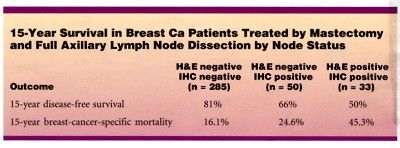Occult Micrometastases in Single Node Predict Worse Breast Cancer Outcomes
ORLANDO-Data from a massive pathologic reanalysis of breast cancer patients with apparently negative lymph nodes show that women with occult micrometastases have shorter disease-free survival and are more likely to die from breast cancer than are women whose nodes are negative on immunohistochemistry.
ORLANDOData from a massive pathologic reanalysis of breast cancer patients with apparently negative lymph nodes show that women with occult micrometastases have shorter disease-free survival and are more likely to die from breast cancer than are women whose nodes are negative on immunohistochemistry.
Lee K. Tan, MD, who led the Memorial Sloan-Kettering research team, presented the study at the 38th Annual Meeting of the American Society of Clinical Oncology (abstract 146). Dr. Tan emphasized that this was not a study of sentinel lymph nodes only, but a reanalysis of multiple nodes removed by axillary dissection.
The widespread use of hematoxylin & eosin (H&E) serial sections and immunohistochemical (IHC) staining for cytokeratin has greatly increased detection of occult or micrometastatic breast cancer. This has decreased the false-negative rate in sentinel lymph node biopsy but sparked new concerns about the importance of the abnormalities detected with these tools.
"Debate has intensified due to sentinel lymph node biopsy. Are we identifying a subset of patients at risk for recurrence, or are we just upstaging them with the risk of over-treatment?" Dr. Tan said.
To answer that question, Dr. Tan and her colleagues conducted an in-depth pathologic reanalysis of specimen blocks from 368 unselected patients with apparently node-negative breast cancer who had been treated with mastectomy and axillary lymph node dissection from 1976 to 1978. The analysis included an average of 17 nodes per patient. Median follow-up among surviving patients was 17.6 years. None had been treated with adjuvant chemotherapy.
A total of 2,470 axillary lymph node blocks were sectioned at two deeper levels 50 µm apart and stained with H&E and IHC. This generated nearly 10,000 slides, the analysis of which formed the basis for Dr. Tan’s report.
Study Results
"We found that 83 of 368 patients (23%) were actually node positive," Dr. Tan said. "Of these patients, 71% had only one positive node, and 77% had positive nodes only at level 1 of the lymph node dissection. In 40% of cases the occult metastases were first detected on H&E staining and confirmed by IHC."
The researchers then correlated lymph node status with clinical outcomes. They found that patients who remained node negative after the analysis had significantly better long-term survival than those with a positive node detected by either H&E or IHC. These patients also had lower breast-cancer-specific mortality (see Table).

Patients with occult micrometastases detectable by H&E had earlier recurrences than those with metastases detected by immunohistochemistry. "The disadvantage in disease-free survival associated with having an IHC-positive node became apparent only after 12 years of follow-up," Dr. Tan said.
Clinical Implications
The main clinical implication is that it may be possible to identify a good-prognosis subset of women with node-negative breast cancer who can be spared adjuvant therapy, Dr. Tan said.
Many clinicians use a tumor size of 1 cm as the cut-off for deciding that a patient with a negative axillary lymph node status should have adjuvant chemotherapy. In this study, the outcome of patients with tumors of 1 to 2 cm and no micrometastases (and no evidence of vascular invasion in the primary tumor) was identical to that of a previous series of patients with lesions of 1 cm or less, Dr. Tan said.
Conversely, among the node-positive patients in this study, the outcome for patients with tumors of 1 to 2 cm resembled that of historical patients with tumors larger than 2 cm.
"If the axillary lymph nodes remain negative following serial sections and IHC, then 1 to 2 cm represents a group of good-prognosis patients who may not require adjuvant chemotherapy," Dr. Tan said.
The practical problem with applying this study to routine clinical practice is a logistical and economic one. Discussant Susan Hilsenbeck, PhD, of Baylor College of Medicine’s Breast Center, said that this approach is too labor-intensive for standard axillary dissection but is feasible when processing sentinel lymph node biopsies. "But that won’t fix the primary problem: that nodes are not perfectly predictive," she said.
Newsletter
Stay up to date on recent advances in the multidisciplinary approach to cancer.